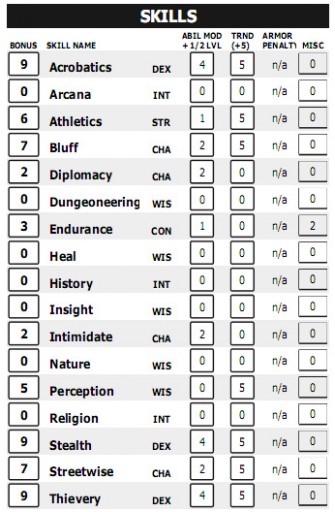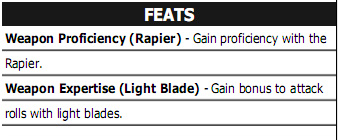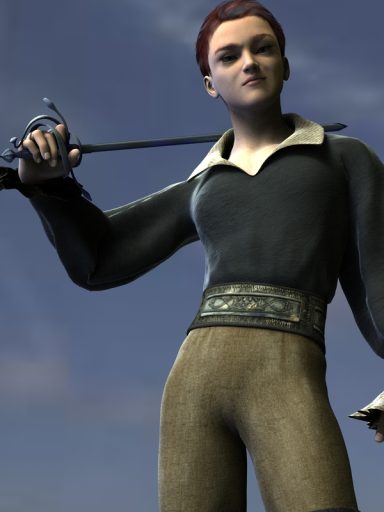Notes: This one is for newcomers to the role-playing hobby, though it doesn’t hurt for us grognards and know-it-alls to be reminded about these things once in a while too! Read on, gentle reader.
Character Sheets are funny things. They are our window into a whole ‘nuther virtual person, yet say so little about them. They tell us about their lifting limits, but nothing about their likes and dislikes, their hopes and dreams. Of all the things written (or printed) on a Character Sheet, what’s missing most of all is…… character.
Except it’s all there, if we only know how to read it properly. I’m not talking about looking at the sheet and being able to say “Oooo! Strength 18” – I’m assuming (rightly or wrongly) that you can read the letters and numbers here – but about how you interpret them. This is an essential role-playing skill, and one which all too often is left out of the Newbie 101 Introduction to Role-playing guide/tutorial/first session. Let’s fix that!
Regardless of system, a Character Sheet is basically a big chunk o’ numbers (and sometimes words) which detail a character’s limits. It shows what their Attributes are relative to the other PCs and the baseline average; it lists their skills, talents and anything which makes their character stand out from the crowd. In some systems, the character sheet also details their weaknesses, drawbacks or limitations though some systems (most notably D&D) leave such things down to pure role-playing.
So show you what I mean about interpreting a character sheet, I’m going to introduce you to Rufio. Here’s his character sheet if you want to view him in full. We’re using 4e D&D as it’s the system most folks are likely to be familiar with, though this should equally apply to any system out there. [1. Except possibly Risus, which is a whole different ballgame.]
Rufio is a 1st level Lawful Good Male Human Rogue. That should tell you bundles to begin with. He respects the law, and is more likely to get into scrapes than actually do anything illegal. He’s a scoundrel or scamp who wouldn’t steal your horse, but might tie a firecracker to its tail just to see what happens. Apple pies tend to disappear around him, but only if they’re left by an open window – he wouldn’t think of breaking in to take it.
On to his stats.
Above average Strength and Constitution speaks of healthy living – perhaps from a Rural background rather than a townie. With a naturally high Dexterity and decent Charisma score, Rufio is something of a showoff. He’ll impress the girls by juggling apples and climb trees faster than anyone else in his village. His Intelligence is slightly above average, but he’s not as clever as he thinks he is; most of his plans tend to be only half thought through.
I give him a Background Option of Farmer. His father owns the farm, but Rufio tends to spend most of his time fleeing from chores instead of actually doing them. That’s good for the +2 to Endurance. Incidentally, Background Options are a terrific way to personalize your character. They don’t provide much of a bonus, but they do add bags of character to your PCs. If you don’t use ’em in your 4e game, you’re missing out on role-playing gold.
When it comes to Skills, he’s trained in Acrobatics, Athletics, Bluff, Perception, Stealth, Streetwise and Thievery. These tie in with his nature as an agile scamp. He has keen eyes and is a decent listener, especially when it’s about things he shouldn’t be listening to. His Streetwise skill comes from hiding under tables in taverns just to pick up the latest gossip. These are all skills which will stand him in good stead in his beginning adventuring career.
What’s equally interesting is the skills which aren’t there. He’s not a good judge of character (no Insight training), and despite coming from a rural background no Nature skill at all. He’s not booksmart, and has little interest in the names of flowers. He has no interest in religion or magic (though flashy magic doubtless impresses him); he is his own boss and feels beholden to no greater power.
So, Rufio is likeable and agile but pretty lazy, all in all. He’s got to be good at something, right? Oh yes – he has one passion. Since the day he “found” his father’s old rapier in the warchest in the attic, Rufio has dreamed of becoming a legendary Halberdier and one of the finest swordsmen in the land. When he skipped his chores and lessons he could usually be found in the woods practising his moves. At first his father despaired, and tried to stop him sneaking out and hiding the blade. When that didn’t work he relented and began to train Rufio himself – after all, if he’s going to learn, it’s better he learn properly.
With the Weapon Proficiency (Rapier) and Weapon Expertise (Light Blades) Feats, Rufio is well on the way toward fulfilling his dream. The moves his father taught him translate into 4e Martial Exploits – Clever Strike, Piercing Strike, Sly Flourish, Sly Lunge and Trick Strike. That, and a letter of recommendation to Lord Warden Markelhay in Fallcrest, should send him on his way.
There you have it. One character, straight from the Character Sheet. Rufio is Tom Sawyer meets d’Artagnan, all stated up and ready to play.
Till next time!









Where did you find the rapier? Or did you download one of the new roguish packages other than the Duelist for David?
.-= EltonJ´s last blog ..By Popular Demand =-.
@Elton It comes with the Leon di Castiglia Clothes from DAZ, and it’s an absolute pain to get a decent Hand pose with it :(
Sounds like the Jack of Hearts or the Duelist for David might be better.
.-= EltonJ´s last blog ..By Popular Demand =-.
@Elton The Duelist is a great set! I’d like to see it updated for M4/H4.
I love the Leon di Castiglia clothes themselves – good, versatile male fantasy clothing is worth its weight in gold. I’m hoping Digiport releases a set of poses and hand grips to go with that rapier soon :D
If not, get the Jack of Hearts. The rapiers have conforming poses. :)
.-= EltonJ´s last blog ..By Popular Demand =-.